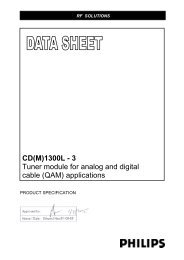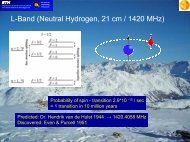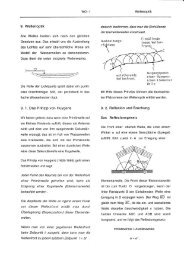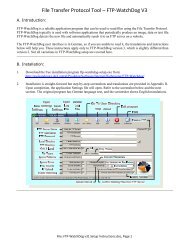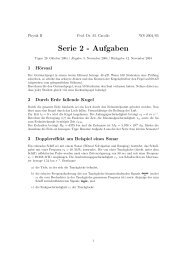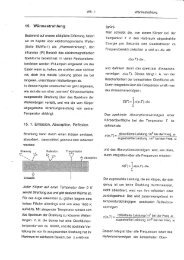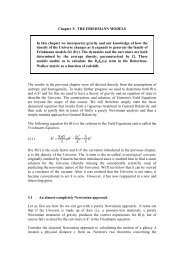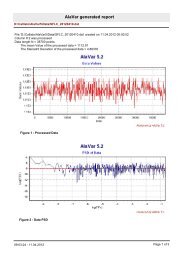here - Institute for Astronomy Umleitung
here - Institute for Astronomy Umleitung
here - Institute for Astronomy Umleitung
You also want an ePaper? Increase the reach of your titles
YUMPU automatically turns print PDFs into web optimized ePapers that Google loves.
Assuming that most of the black hole mass of<br />
present-day galaxies was assembled around<br />
the period of maximum AGN space densities,<br />
between z ~ 1 and z ~ 3 (Wolf et al 2003), the<br />
task is to establish an evolutionary link<br />
between AGN at high z and the local galaxy<br />
population. Such a link can be built by<br />
studying the environments of AGN and<br />
characterising the degree of overdensities they<br />
live in. Luminous radio-loud quasars and radio<br />
galaxies beyond z ~ 1 are typically located in<br />
rather rich structures, probably progenitors of<br />
the most massive clusters today<br />
[REFERENCE]. The environment of lower<br />
luminosity radio-quiet AGN at high z, on the<br />
other hand, is not well constrained. A set of<br />
MUSE pointings on a representative AGN<br />
sample, of a few hours exposure time each,<br />
would yield a complete census of the 100-200<br />
kpc surroundings down to significant sub-L*<br />
luminosities at z=1 and to roughly L* at z=3.<br />
At the same time one would get the velocity<br />
in<strong>for</strong>mation needed to assess the degree of<br />
virialisation in a given structure.<br />
Title: Science Case<br />
Reference: MUSE-MEM-SCI-052<br />
Issue: 1.3<br />
Date: 04/02/2004<br />
Page: 43/100<br />
Figure 2-24: This 1 arcmin x 1 arcmin section of<br />
an HST image in the Chandra Deep Field South<br />
contains 7 X-ray sources, most of which are likely<br />
AGN at intermediate to high redshifts. Some of<br />
these sources were already targeted<br />
spectroscopically with the VLT, but are optically<br />
too faint to give a meaningful spectrum. A single<br />
deep MUSE exposure would not only clarify the<br />
nature of these, but at the same time allow to<br />
study their host galaxies and environments. Image<br />
taken from the GEMS project.<br />
Gravitational interaction and merging are believed by many to be the main drivers <strong>for</strong> driving<br />
nuclear activity. But what exactly are the conditions needed to trigger an AGN? Until today,<br />
the search <strong>for</strong> morphological clues has largely prevailed, but spectroscopic diagnostics can<br />
deliver additional, possibly crucial pieces of evidence. A single MUSE data cube could reveal<br />
also, <strong>for</strong> example, large-scale gas streamers, patterns of enhanced star <strong>for</strong>mation in the AGN<br />
host as well as in other galaxies in the field, and kinematical signatures of recent merger<br />
events, thus provide essential clues about the physical drivers of cosmic AGN evolution.<br />
Most of the sketched AGN studies would have to be per<strong>for</strong>med in pointed mode, targeting<br />
individual pre-selected objects. The "blind" MUSE surveys outlined elsew<strong>here</strong> in this<br />
document provide a chance to integrate the AGN aspect into a multi-purpose survey, by<br />
judiciously selecting survey fields to coincide with deep X-ray pointings. Recent surveys with<br />
Chandra and XMM have yielded surface densities of more than 3 X-ray sources per arcmin2,<br />
a large fraction of which is presumably directly linked to some sort of AGN phenomenon.<br />
These surveys are still largely photon-limited, and even deeper pointings are being considered<br />
which would increase the surface density by at least another factor of 2 (Alexander et al<br />
2003). The suggested concepts of "shallow" and "medium deep" MUSE surveys could in fact<br />
revolutionise the traditional strategy of X-ray imaging/spectroscopic follow up. In particular,<br />
spatially resolved in<strong>for</strong>mation <strong>for</strong> every single X-ray AGN would become available at once,<br />
allowing to deblend the nuclear from the host galaxy spectrum and obtain a much cleaner<br />
spectral diagnostic. At the same time, kinematics and environmental in<strong>for</strong>mation would<br />
become available, with all the benefits mentioned.




